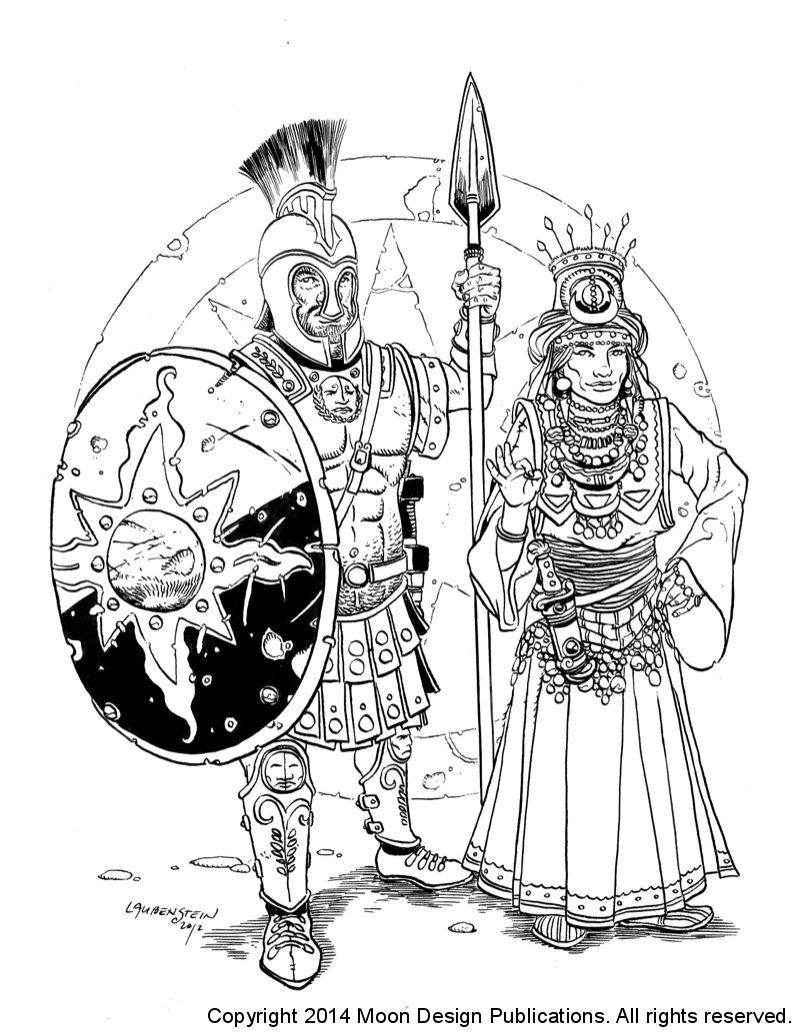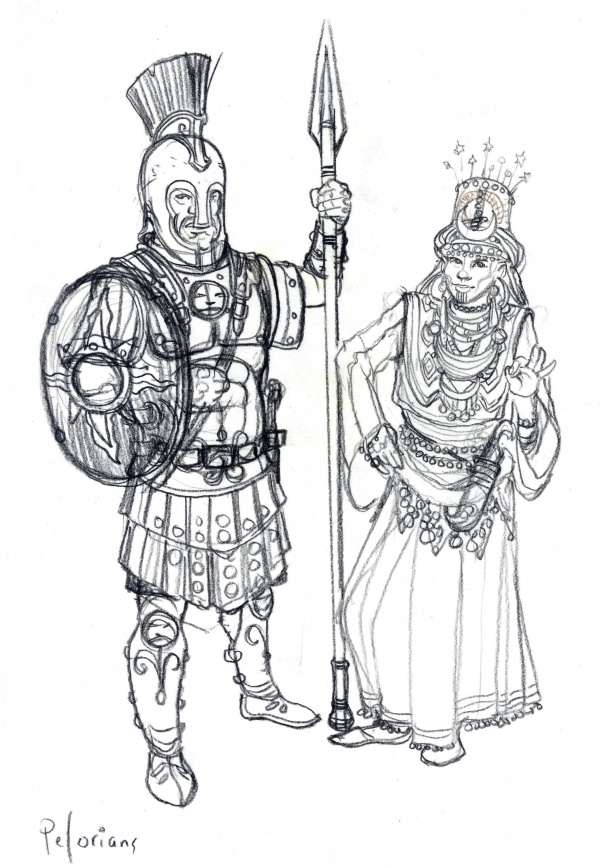The Pelorians are a proud and ancient civilization of riverine city-states united by a divine emperor descended from the Moon Goddess. They are Bronze Age or Early Iron Age in culture and comparable to the ancient civilizations of Babylon, Assyria, or Achaemaenid Persia (with some trappings from Hellenistic Greece and the Roman Empire thrown in for good measure). Their society is extremely socially stratified and strongly patriarchal, but the Lunar religion offers opportunities for women to hold positions of power and prestige.
The Pelorians are light-skinned (ranging from pale to olive), with brown to blonde hair. Brown and blue eyes are prevalent. Men grow full beards and trim their mustaches. Basic dress consists of a skirt, tunic, jacket, cloak or sleeved robe, and headdress. Clothing is strictly regulated by social class. Commoners have fewer pieces of clothing and the skirt cannot extend below the knee: higher class citizens wear more clothing (and what they have is more ornate) and can wear their skirts and robes longer. Nobles wear long robes and skirts that drag on the floor and must be carried over ground by servants. Headdresses are common for men and women. In some regions, they are embellished with gold and silver coins, Decorative veils and face coverings are common among higher-class women.
Some regions paint themselves with henna, painting runes and other magical symbols on their hands and feet.
Weapons are Bronze Age, and the Pelorians are renowned for their heavy infantry, disciplined spearmen armored with bronze cuirasses and plumed helmets. Peloria is also feared for its disciplined cavalry, armed with bows, lances and curved swords, and effective against both the Pentan nomads and the barbarian nations of the upland hills.
Fig. 1. Dara Happan hoplite. Dara Happa is a rich and broad valley along the Oslir River, densely populated with ancient cities. It has continental climate with hot summers and cold winters. The people are average size for humans and they view themselves as the natural rulers of the world.
Our male Dara Happan hoplite wears a bronze cuirass with gold decorations (like this http://images.metmuseum.org/CRDImages/gr/web-large/DP251338.jpg but with gold decorations) and bronze greaves (perhaps decorated with the faces of protective gods or spirits, like http://upload.wikimedia.org/wikipedia/commons/f/fa/Bronze_greaves_BM_GR1856.12-26.615.jpg). Underneath his cuirass he wears a red tunic that reaches down between his calves and his knees. Leather pteruges decorated with silver coins hang from his sword belt and protect his groin (http://www.tastenboard.de/uploads/images/cingulum-4). The sword at his left side is curved like a falcata or kopis (http://www.wulflund.com/images_items/greek-falcata-sword_2.jpg) and in an ornate sheathe (http://img91.imageshack.us/img91/1600/g27bc.jpg). In his hand he carries a spear with a bronze spearhead. His shield is bronze and is decorated with a golden eight pointed star (http://www.theishtar.com/resources/600px-Ishtar-star-symbol.svg.png.opt394x394o0,0s394x394.png).
He has a long blonde beard and trim mustache, but little can be seen of his face, since he wears a bronze helmet in the Corinthian style (http://farm2.static.flickr.com/1330/1134340712_520d4ca0a0.jpg). It is decorated with an impressive crest of horsehair, feathers, and plumes (like this http://www.ancientreplicas.com.au/images/st/st_SmallHighCrest.jpg). His helmet and weapons are inlayed with the runes of Fire, Stasis, and Death.
Fig. 2. Orayan Lunar cultist. Oraya is an eastern province of the Lunar Empire bordering the endless grasslands of Pent. It was settled from the interior of the Lunar Empire a little over a century ago and is home to many diverse religions, mystery cults, and barbarous sects. It has hot summers and colder winters than Dara Happa. The Orayans tend to have brown or black hair, but blonde and even red is not unknown.
Our Orayan Lunar cultist wears ornate loose robes of black and red like http://upload.wikimedia.org/wikipedia/commons/thumb/c/c7/Bersheba_dress.jpg/303px-Bersheba_dress.jpg and http://www.zawaj.com/weddingways/images/egypt/egyptian_bedouin_woman.jpg. The robes are decorated with jewelry and beads, and marked with the Moon Rune, and with various Lunar Runes from the following site: http://www.etyries.com/moonie/moonrune.htm. Her hands are painted in henna with those runes as well. She carries a curved sickle-knife in her belt (http://southernsudan.prm.ox.ac.uk/images/midsize/1917.25.27_a.jpg).
She wears an ornate veil decorated with silver coins (such as http://upload.wikimedia.org/wikipedia/commons/thumb/c/c7/Bersheba_dress.jpg/303px-Bersheba_dress.jpg and http://4.bp.blogspot.com/-F0PbGLJkpIw/Tjex65SZShI/AAAAAAAAHhc/_ViWhmo1Xvg/s1600/shopping%252520page%252520-%252520bedouin%252520woman.gif).
The veil permits sight of her eyes, which are darkly painted with kohl.
Below: Preliminary sketch of two Pelorians by Jeff Laubenstein:
And the final piece

Related Pages
- Art of the Guide to Glorantha
- FAQ about the Guide to Glorantha
- Guide Art Direction – Aldryami
- Guide Art Direction – Mostali
- Guide Art Direction – Orlanthi (2013)
- Guide Art Direction – The Seven Faces of Arkat (2013)
- Guide Art Direction – Hsunchen (2013)
- Guide Interview – Greg Stafford (2012)
- Guide Interview – Jeff Richard
- Guide Interview – Mark Rein-Hagen
- Guide Interview – Rob Heinsoo
- Guide Overview – Fonrit
- Guide Overview – Kralorela
- Guide Overview – Praxian
- Guide Overview – The West
- Guide to the Guide to Glorantha
Page Last updated: 2025-03-02 15:45:43

